The Russian Army has recently received the first batch of T-90M main battle tanks. The upgraded variant of the T-90 was developed by the T-90 manufacturer Ural Vagon Zavod (UVZ) enterprise. The plant, located at Yekaterinburg in the Ural region, is one of two major tank manufacturers in Russia, a producer of tanks since the T-54/55, 72, T-90 to the Armata family MBT.
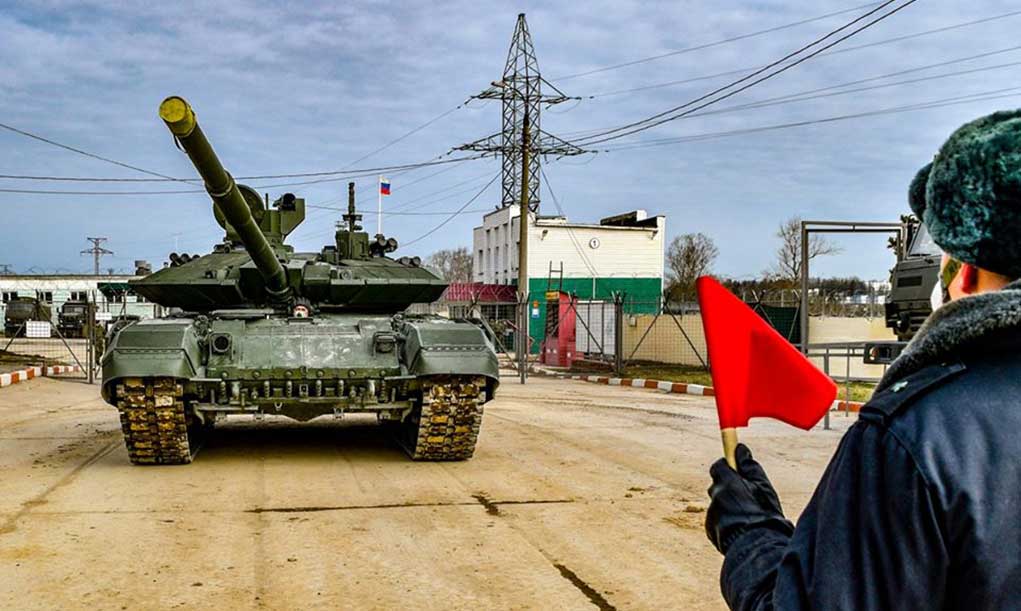
The latest upgraded version of the T-90 – the Proryv-3 (Breakthrough) T-90M has recently completed field tests by the Russian Ministry of Defense, commencing deliveries to field units. In April 2020, the Russian MOD reported the first deliveries to the Tamanskaya Motor Rifle Division, a unit of the Guard Tank Army deployed in the Western Region. The unit and its new tanks are expected to take part in the 9 May victory parade in Moscow. In the coming years, the Russian Army is also fielding upgraded variants of the T72M, T72B3M, and T80BVM. The Russian MOD plans to upgrade 350-400 T-90s to the new standard, deferring mass production of Armata tanks due to their high cost.
These tanks provide a temporary solution addressing capability gaps and technological advancement before deploying next-generation AFVs such as the T-14/15. While the next-generation tanks are already developed, they still face technical hurdles and are too expensive for large scale procurement. The cost of T-14 Armata MBT is estimated at US$8-12 million, compared to $1.5-2.5 million, the cost of an upgraded T-90. Nevertheless, the T-90M benefits from technological achievements and systems implemented in the expensive export version T-90MS and the Armata MBT.
Some of the outstanding new features of the T-90M are a new turret mounting an improved version of the 2A46 125mm stabilized cannon. Improved precision derives from the muzzle drop measurement and fire control systems borrowed from the new T-14 Armata tank. This cannon fires kinetic rounds that are longer and faster than previous rounds, thus being able to penetrate thicker armor. The fire control is programmed to fire three types of rounds – High-speed Kinetic (APFSDS), HEAT-AT, and High Explosive airburst fragmentation projectile, used against soft targets and structures. Gun-launched anti-tank missiles of the 9M119 Svir/Refleks family (NATO Reporting Name: AT-11 SNIPER) are used against targets at ranges up to 5,000 meters. The tank can also use the entire range of older ammunition.
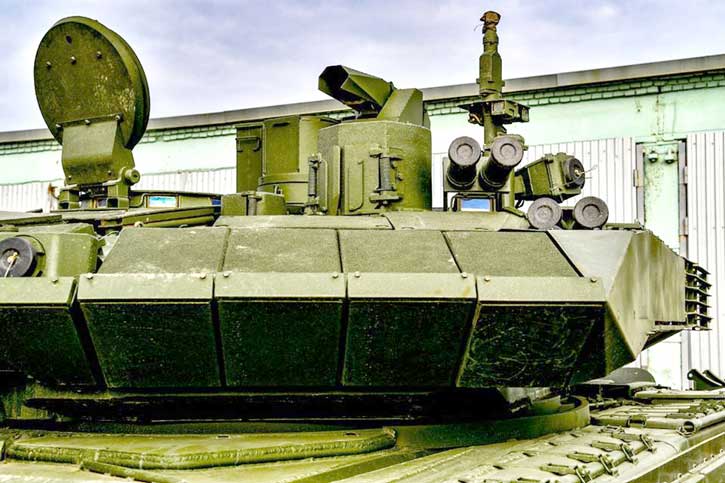
A coaxial 7.62mm machine gun is placed along with the main gun. The KORD-MT remotely controlled weapon station that mounts a 7.62/12.7 mm machine gun is placed near the commander’s cupola and is controlled by the crew from inside the vehicle. This method was also employed in the T-14 and T-90MS. The turret shape enabled designers to increase the ammunition stowage by 3 (to a total of 43 rounds), of which 22 – 24 pairs of projectiles and propelling charges are placed in the automatic loader’s carousel (plus 4-6 missiles). The remaining rounds and propelling charges are stored in a new turret bustle rather than in the crew compartment, thus avoiding the risk of explosion.
Related post: New KE Ammunition for Russian Tanks
Another new system implemented here is the Kalina automatic target tracker and fire control computer developed for the T-14. This system enables the gunner to lay the gun on target, lock, and automatically fire while on the move.
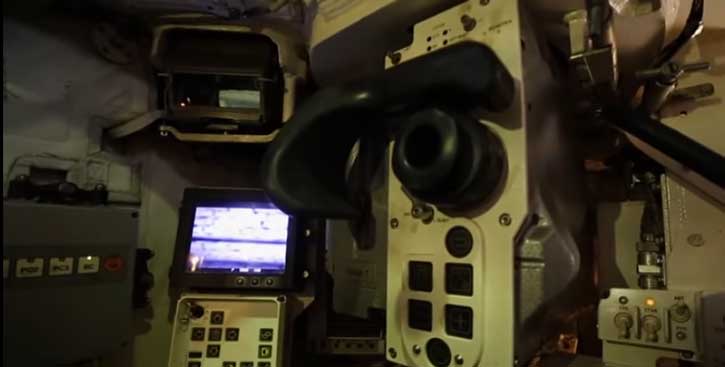
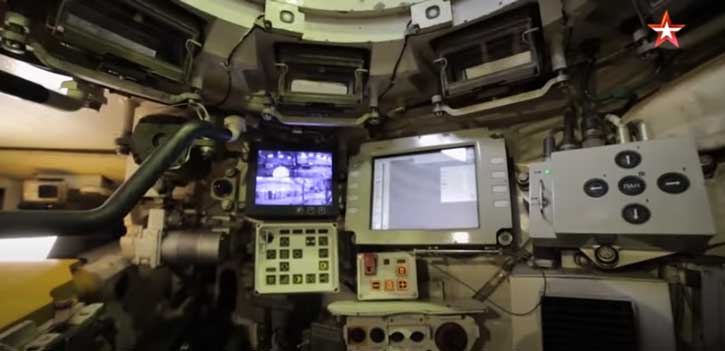
The tank has an independent panoramic commander’s sight with day/night channels. The gunner uses a separate sight, laser rangefinder, and a missile director associated with the beam-riding gun-launched REFLEKS missiles.
The lack of soft or hard-kill APS hints the Russian Army has been satisfied with the level of protection its new tank provides. The level of protection of the T-90M has been improved to defeat kinetic threats capable of penetrating 1,100 to 1,300 mm and shaped-charge threats penetrating up to 1,350 mm of rolled homogenous steel (RHS).
Additional protection layer was added to withstand such threats, comprising steel plates added with the 3rd generation reactive protection known as RELIKT. Additional protection using statistical protection is added around the turret and engine compartment at the rear. The lower sections of the turret sides and rear are applied with net-shaped RPG-protection, with slat-type armor applied to the engine compartment sides and rear. The type can also use large reactive protection bags applied to the sides, on top of the bazooka plates, protecting against roadside IEDs and EFP.
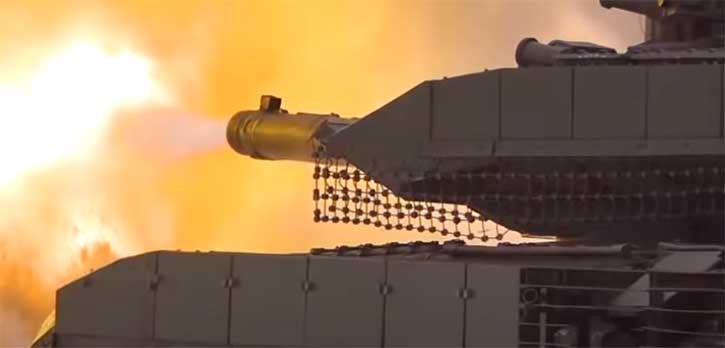
These add-on armor solutions were developed based on the lessons learned during the Syrian Civil War, where T-72 tanks suffered significant losses to anti-tank guided missiles and RPGs. Similar configurations are also applied to T-72 tanks and BMPT Terminator infantry support tanks. While earlier T-90 versions were equipped with the SHTORA-1 soft-kill active defense system comprised of two ‘red eye’ infra-red flashlights, the current variant does not use such measures, Russian sources relate to it as ‘laser countermeasures’. Four units are mounted on the turret, two units are pointed forward and two sideways. Further protection is provided by the 81mm multi-spectral canisters deploying smoke screens, which can be triggered by the laser warning.
An interesting note is the lack of hard-kill active protection means. The Russian MOD has evaluated several types of APS, including ARENA on T-72/90 and AFGANIT on T-14/T-15 and other AFVs. It has been confirmed that models of the T-90SM have been equipped with APS addressing foreign interest, but apparently, lack of such interest in Moscow has left the T-90M without such protection.
The new design also reduces the tank’s signature, especially in the thermal reduction of engine exhaust heat.
With the 1,300 hp engine (up from 1,000 hp of the T-90S) the 46.5-ton vehicle has a 1:26 power to weight ratio, thus maintaining good mobility and obstacle crossing capability, particularly when assisted with the integral dozer blade, assisting the tank in digging up firing positions. For mobility in muddy terrain tank units employ tree log barricades built from trunks carried on each tank. Traditionally these trunks are placed in the rear, but the T-90M carries its log on the starboard side (right side), thus enabling a quick release.
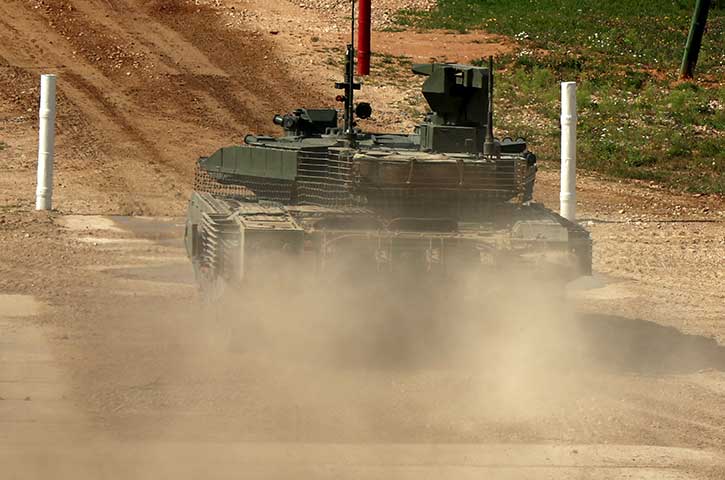
Measurements:
- Gross Vehicle Weight: 46.500 kg
- Length: 9.430 (Chassis only: 6.900 m.)
- Width: 3.800 m.
- Height: 2.200 m.
- Crew: 3
Firepower:
- Main Gun: 2A46M-4/8
- Elevation: -6 +14
- Ammunition: 40-43 (22 in carousel)
Protection & Survivability:
- Hull: Welded steel
- Add on armor: RELIKT reactive armor
- Anti-RPG net around the turret
- Soft kill: Laser detection & Warning, Multi-spectral Smoke
Mobility:
- Powerplant: Diesel 1,300 hp
- Max speed: Road: 60-70 km/h, off-road: 45 km/h
- Autonomy: 550 km
from Defense Update: https://ift.tt/2VGqdXb
via Defense News
No comments: